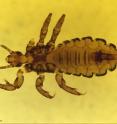Of lice and man: Researchers sequence human body louse genome
They make you itch and they are hard to find but scientists have got the body louse well and truly in their sights. A multi-institutional team has recently sequenced the body louse genome, an achievement that will yield new insights into louse – and human – biology and evolution. The body louse genome is the smallest known genome of any insect, said University of Illinois entomology Professor Barry Pittendrigh),who led the drive to fund the project and coordinated the international team of scientists who analysed the sequence.
Australian team member, Dr Stephen Cameron from CSIRO Entomology is researching the gene that is responsible for body lice responding to their environment.
"Lice have a simple life either in your hair or on your body with blood as their food. So most of the genes responsible for sensing their environment have been reduced," Dr Cameron said.
"One gene in particular is responsible for normal cell maintenance and in the body louse this gene is missing. This can give valuable insights into diseases and human ageing."
John Clark, of the University of Massachusetts at Amherst, and Si Hyeock Lee, of Seoul National University, led the analysis of the enzymes of the louse and found that lice have the smallest number of detoxification enzymes observed in any insect.
The body louse's pared-down list of detoxifying enzymes makes it an attractive organism for the study of resistance to insecticides or other types of chemical defense, Professor Pittendrigh said. University of Illinois entomology Professor and department head May Berenbaum and former graduate student Reed Johnson contributed to this effort.
The body louse is also known to transmit lethal diseases such as typhus whereas its close relative, the head louse, does not. This study is helping explain the differences between these two insects as to which genes are involved in transmitting disease.
Other work that the team was involved in included sequencing the genome of a microbe that lives in the body louse gut. This research revealed that the body louse is not just dependant on humans for survival but also a particular bacteria which aids in the production of an essential nutrient.
This will make the body louse a useful tool for understanding co-evolution of disease carrying parasites and their bacterial co-conspirators.
Source: CSIRO Australia
Other sources
- Of lice and man: Researchers sequence human body louse genomefrom Science BlogMon, 28 Jun 2010, 14:07:49 UTC
- Lice genome sequence foundfrom Science AlertMon, 28 Jun 2010, 8:21:18 UTC
